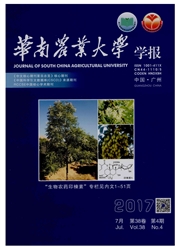

 中文摘要:
中文摘要:
【目的】实现黏性土壤离散元模型的接触参数与接触模型参数标定。【方法】基于土壤堆积角物理试验结果,采用考虑颗粒间黏结力的“Hertz-Mindlin with JKR”接触模型进行土壤堆积角仿真试验,借助GEMM(Generic EDEM material model database)数据库获得离散元模型关键参数(包括JKR表面能、恢复系数、静摩擦系数与动摩擦系数),进一步运用Box-Behnken试验方法进行堆积角仿真试验。【结果】通过对试验结果进行多元回归拟合分析获得了堆积角回归模型,回归模型的方差分析表明该模型极显著,试验因素对堆积角的影响为二次多项式,且存在复杂的一次与二次交互作用。以堆积角40.45°为目标对回归模型进行寻优,得到了优化解:JKR表面能7.91 J·m^-2;恢复系数0.66;静摩擦系数0.83;动摩擦系数0.25。以此优化解进行仿真试验获得的堆积角为39.73°。堆积角仿真试验与物理试验在堆积角度和形状上具有较高的相似性。【结论】可利用该优化参数对样品土壤进行进一步的黏性土壤与触土部件间的离散元仿真,从而揭示黏性土壤在触土部件作用下的运动规律。
 英文摘要:
英文摘要:
【Objective】 To calibrate contact parameters and contact model parameters for the cohesive soil discrete element model. 【Method】The Hertz-Mindlin with JKR contact model which consider the cohesion between particles was employed for the repose angle simulation test. The simulation test was based on the results of physical test for angle of repose. The key parameters including JKR surface energy, coefficient of restitution, coefficient of static friction and coefficient of rolling friction were obtained from the GEMM (Generic EDEM material model) database. A Box-Behnken design was then used to perform the simulation test for repose angle in above value ranges. 【Result】The regression model for repose angle was acquired from the test results by multiple regression analysis. Analysis of variance showed that the model was extremely significant, and the relationship between experimental factors and repose angle was fitted to a quadratic polynomial with complex liner and quadratic interactions. The optimized solution was acquired by using 40.45° as the target of repose angle. The optimized solution was as follow, JKR surface energy was 7.91 J·m^-2, coefficient of restitution was 0.66, coefficient of static friction was 0.83, and coefficient of rolling friction was 0.25. The optimized solution was then used for simulation test and the obtained repose angle was 39.73°. The simulation test was highly matched with physical test on both angle and shape of repose. 【Conclusion】 For the soil sample used in this research, the optimized parameters can be used for further simulation of kinematics and dynamics between cohesive soil and soil contact components, and for providing the motion characteristics of cohesive soil under the actions of soil contact components.
 同期刊论文项目
同期刊论文项目
 同项目期刊论文
同项目期刊论文
 期刊信息
期刊信息
